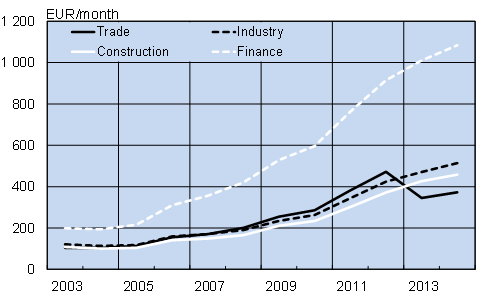BOFIT Weekly Review 26/2015
Chinese wages continue to rise, though at a slower pace
The average wage for city workers last year rose 9 % to around 4,700 yuan (€560). Wages were up in all major sectors: manufacturing 10 %, wholesale and retail trade 9 %, construction 9 % and finance 9 %. In euro terms, wages were up about one percentage point less as the yuan strengthened against the euro in 2014.
The overall wage growth slowed from 10 % in 2013 as expected. Wages continued to rise rapidly, however, and wage hikes were large also in real terms as inflation remained below 2 % last year.
There are significant regional variations in labour market conditions and wages. Wages have climbed fastest and been highest in the big cities and fast-growing coastal regions. For example, a survey of Standard Chartered Bank found that industrial firms in the coastal Guangdong province this year again expect to face labour shortages. In particular, they expect that they will have to raise migrant worker wages in the province more than 8 %.
Wages in China have risen on average more than 15 % a year over the past ten years, giving indication about the huge productivity gains the country has made. Total productivity has risen dramatically as millions of under-employed people from rural areas have moved to work in cities. As the growth in the inflow of migrant labourers has slowed, productivity gains have been invoked by production shifting to producing goods with more value added.
The rapid rise in wages also indicates pressures in China’s labour markets as the coastal industrial regions face labour shortages. The slowdown in economic growth and lower growth in demand for workers in part explain the slowdown in the rise of wages. In addition, pressure to raise wages further will be eased by the fact that labour-intensive industries are shifting their production to emerging economies where labour costs are lower.
Average monthly wages by branch

Source: Macrobond